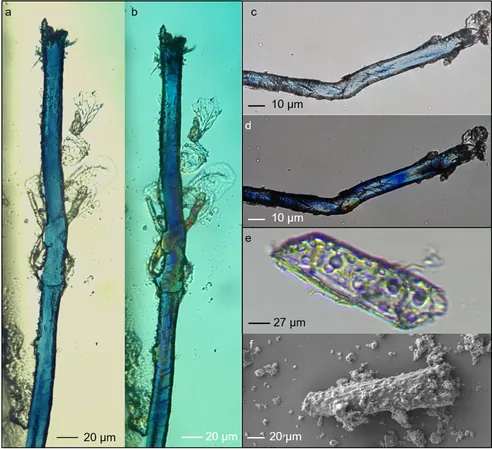
Ancient Blue Dyes: A 34,000-Year-Old Mystery Revealed!
2025-09-02
Author: Rajesh
Unlocking Paleolithic Secrets with Indigo
An innovative international team from Ca' Foscari University of Venice has made an extraordinary discovery: traces of indigo, a vibrant blue dye, on ancient stone tools from 34,000 years ago! This groundbreaking find, outlined in the journal PLOS One, has opened a new chapter in understanding how our Paleolithic ancestors interacted with their environment.
Indigo: More Than Just a Color
The indigo found on these tools comes from the leaves of **Isatis tinctoria L.**, commonly known as woad, a biennial plant native to the Caucasus. This ancient artifact marks the very first time this colorful compound has been detected on such old objects, suggesting early humans recognized the plant's potential beyond mere nutrition.
Sophisticated Plant Use in Prehistoric Times
"This discovery challenges the long-held view that plants were mainly food sources for our ancestors," says archaeologist Laura Longo. "It reveals that they were also skilled in processing plants for dyeing and possibly medicinal uses, showcasing their resourcefulness and cultural sophistication." Early Homo sapiens were apparently capable of transforming plants into valuable materials for multiple aspects of daily life.
From the Caucasus Caves: A Historical Harvest
The tools were dug up from Dzudzuana Cave, a site rich in archaeological significance, where excavations have been ongoing since the early 2000s. Led by renowned researchers, these tools were analyzed in detail, pinpointing their age to this fascinating period when humans were beginning to harness the full potential of their surroundings.
Discovering the Science Behind the Dyes
Upon examining the tools, researchers initially sought to understand their function but stumbled upon unexpected blue residues alongside starch grains—hints of ancient plant processing. Using advanced spectroscopy techniques, they confirmed the presence of indigo on the working surfaces of these prehistoric tools.
Pursuing Clues in Porosity and Residues
To uncover how these residues were formed, the team investigated the porosity of the stones, which plays a crucial role in trapping organic materials. Cutting-edge analyses revealed suitable pores for preserving plant residues, allowing the researchers to replicate ancient conditions. They even conducted experiments with modern woad to create a reference collection for comparison.
A New Era in Understanding Prehistoric Lives
Through meticulous experimentation and analysis over several years, this remarkable study has illuminated the complex behaviors and knowledge of prehistoric human groups. By demonstrating their ability to exploit plant resources for diverse uses, the findings provoke a reevaluation of how we view our ancestors and their intricate relationship with nature.
Concluding Thoughts: A Window into the Past
With each new discovery, our understanding of early human lifestyles grows richer. This revelation about indigo processing not only paints a vibrant picture of the past but also prompts us to reconsider the cultural significance of plants in the early days of humankind.





 Brasil (PT)
Brasil (PT)
 Canada (EN)
Canada (EN)
 Chile (ES)
Chile (ES)
 Česko (CS)
Česko (CS)
 대한민국 (KO)
대한민국 (KO)
 España (ES)
España (ES)
 France (FR)
France (FR)
 Hong Kong (EN)
Hong Kong (EN)
 Italia (IT)
Italia (IT)
 日本 (JA)
日本 (JA)
 Magyarország (HU)
Magyarország (HU)
 Norge (NO)
Norge (NO)
 Polska (PL)
Polska (PL)
 Schweiz (DE)
Schweiz (DE)
 Singapore (EN)
Singapore (EN)
 Sverige (SV)
Sverige (SV)
 Suomi (FI)
Suomi (FI)
 Türkiye (TR)
Türkiye (TR)
 الإمارات العربية المتحدة (AR)
الإمارات العربية المتحدة (AR)